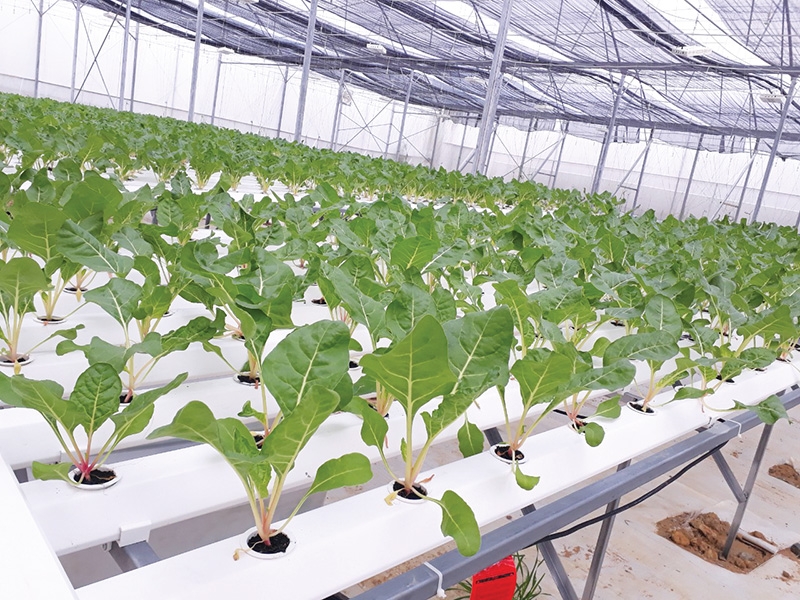Phu Yen to rise as high-tech agriculture hub
 |
| Despite the complexities of this year, agricultural production value continues to rise |
To date, Phu Yen has succeeded in shaping a raft of high-quality agricultural production areas aligned with associated supply chains. Most eminent of them is Phu Yen High-tech Agriculture Zone, which was established in 2013 and is one of 10 high-tech agriculture zones inserted in Vietnam’s master planning to 2020, with a vision towards 2030.
According to the Phu Yen High-tech Agriculture Zone Management Authority, the zone has engaged in deploying six components in the first-phase infrastructure development project over 460 hectares with total investment reaching VND520 billion ($22.6 million).
The work was kick-started in 2016 and thus far has completed and put into operation four components that are all essential to bring the high-tech zone into official operation.
Nguyen Van Hung, director of the authority, said that the infrastructure project components are in the finishing stages, ensuring conditions to attract new investment into the zone’s development in parallel to bringing improvements to local agricultural production practices.
In recent months, the authority has been joining investors to push up technology transfer for local people, helping farmers gradually alter mindsets and production methods, from there establishing diverse high-tech agricultural production areas in the locality for the creation of quality and competitive products in the market.
These altogether aim to lift Phu Yen’s agriculture to new heights with a raft of competitive products such as pear-shaped melons; Japanese cucumbers, authentic banana varieties of local and foreign origins; orchids like Ho Diep and Dendro; and local valued herbal plants, particularly Dang Sam, known popularly as Vietnamese ginseng.
The province has also completed growing and preserving four kinds of starch separation microorganisms, and succeeded in producing bio-products made of rice bran and cassava starch, and more.
Hung noted that as of now the authority has secured investment for nine projects worth VND670.5 billion ($29.15 million) in capital value and covering 184.4ha. The projects are on growing kaoliang, herbal plants, flowers, vegetables, and mushrooms; along with raising and propagating Japanese Koi fish and producing bio-organic fertilisers.
In light of a recent report by Phu Yen People’s Committee, after more than five years of implementing the project on agricultural sector restructuring following the prime minister’s Decision No.899/QD-TTg issued in 2013 approving the project “Agricultural restructuring towards raising added values and sustainable development”, and the plan on agricultural sector restructuring for the 2017-2020 period under the prime minister’s Decision No.1819/QD-TTg released in 2017, the provincial agricultural sector has been pushing up the application of science and technology progresses, and bolstering production efficiency attached to processing, agricultural, and rural services development.
Although it has faced numerous difficulties recently, the sector has still managed a stable growth averaging 4 per cent in the added value annually during 2016-2020. The production value grew an average 4.5 per cent per year, ensuring successful implementation of the project’s targets and contributing 23.94 per cent total productivity value in the province’s economic structure.
Tran Huu The, Deputy Chairman of Phu Yen People’s Committee, however noted that albeit after restructuring the agricultural sector and reached set targets, both quality and efficiency are still limited with a slow pace of restructuring across the board. The proportion of animal husbandry and seafood in the total economic structure remains modest while the value produced on a unit of cultivated land stands low.
Phu Yen, therefore, has set forth several tasks and measures to promote agricultural sector restructuring in the upcoming time. They include further enhancing consciousness and creating high consensus in society to ensure an effective reshuffle of the agricultural sector in particular to avail of the advantages of the province and each area.
This is deemed a top priority by management bodies from central to local level. It is also deemed important to revise existing policies and mechanisms to improve the quality of project implementation, striving to achieve regional GDP growth of the agriculture-forestry-fishery sector from 3.9-4 per cent annually during 2021-2025.
Efforts are also being geared towards encouraging investors to partake in the quality rice production chain through introducing more incentives; working on intellectual property rights protection for the province’s specialty products such as Phu Yen lobsters and O Loan oysters, and propelling implementation of the ‘One Commune, One Product’ scheme with innovation in production and consumption methods to boost efficiency.
What the stars mean:
★ Poor ★ ★ Promising ★★★ Good ★★★★ Very good ★★★★★ Exceptional
Related Contents
Latest News
More News
- Global partnerships key to Vietnam’s IFC development (December 26, 2025 | 16:18)
- Vingroup pulls out of bid to invest in North-South high-speed railway (December 26, 2025 | 11:42)
- Strengthening supply chains through trade promotions and customs reform (December 24, 2025 | 14:00)
- PM orders investment model for North–South high-speed rail (December 22, 2025 | 17:43)
- LS Eco Energy to invest in Vietnam rare earth sector (December 22, 2025 | 17:31)
- Government moves to establish International Financial Centre (December 21, 2025 | 21:00)
- Vietnam's IFC to target global investment flows (December 21, 2025 | 18:00)
- Two national hospitals expand capacity with new facilities (December 20, 2025 | 09:00)
- Ha Tinh breaks ground on major Vingroup industrial and energy projects (December 19, 2025 | 18:24)
- EVN launches major power infrastructure projects nationwide (December 19, 2025 | 18:17)

 Tag:
Tag:





















 Mobile Version
Mobile Version